Nearly 2 out of 3 nursing homes are understaffed. These 10 charts explain why aged care is in crisis
- Written by Emil Jeyaratnam, Data + Interactives Editor, The Conversation
The Royal Commission into Aged Care Quality and Safety begins hearings on residential aged care facilities, or nursing homes, in Sydney today.
The standards of nursing homes in Australia have been in the public eye since the Oakden Aged Mental Health Care Service in Adelaide became embroiled in an elder abuse and neglect scandal, sparking reviews, inquiries and investigations across the sector. This was the most prominent of a series of incidents of abuse and negligence that eventually led to the establishment of a royal commission.
So what are the challenges facing nursing homes and why are they under so much strain?
How many Australians use aged care services?
In the 2017-18 financial year, more than 1.2 million Australians accessed some form of aged care service:
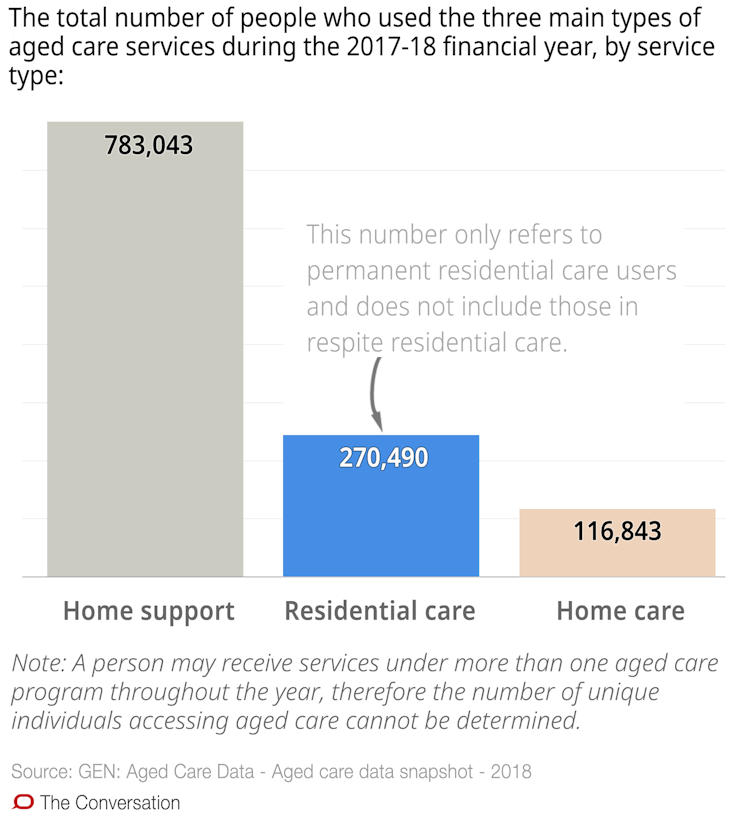 Residential care is the most resource-intensive category of aged care, providing higher level care to older Australians with complicated medical needs, those in the last years of life, and people who can no longer live independently in their own homes.
Read more:
Don't wait for a crisis – start planning your aged care now
How old are residents?
A large proportion of aged care residents are 90 and over. This reflects the increasing preference of older Australians to remain in their own homes longer, and only moving into residential care when home care is no longer adequate.
Residential care is the most resource-intensive category of aged care, providing higher level care to older Australians with complicated medical needs, those in the last years of life, and people who can no longer live independently in their own homes.
Read more:
Don't wait for a crisis – start planning your aged care now
How old are residents?
A large proportion of aged care residents are 90 and over. This reflects the increasing preference of older Australians to remain in their own homes longer, and only moving into residential care when home care is no longer adequate.
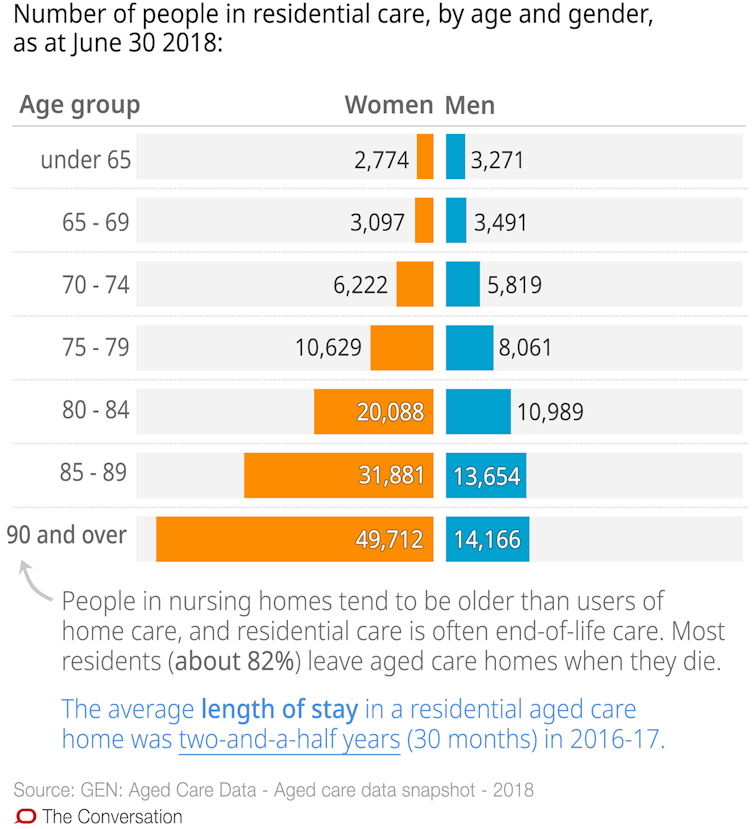 Why aren’t you guaranteed a place?
Australia has a relatively large proportion of older people, with more than 15% of the population aged 65 years or over, which has resulted in strong demand for aged care places.
In 2017-18, almost a quarter of a million Australians (241,723) were approved for residential aged care, but just over 207,000 places were available. This left a shortfall of 34,581 places.
Why aren’t you guaranteed a place?
Australia has a relatively large proportion of older people, with more than 15% of the population aged 65 years or over, which has resulted in strong demand for aged care places.
In 2017-18, almost a quarter of a million Australians (241,723) were approved for residential aged care, but just over 207,000 places were available. This left a shortfall of 34,581 places.
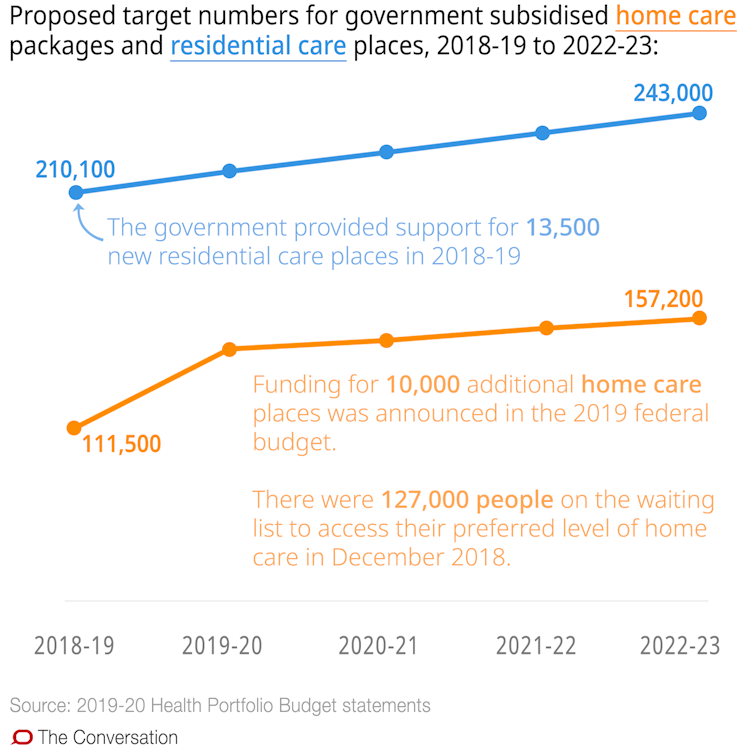 The aged care provision ratio
The supply of home care packages and residential care places is determined using the aged care provision ratio. The ratio will increase from its current target of 113 subsidised care places for every 1,000 people aged 70 and over to 125 places by 2021-22.
The aged care provision ratio
The supply of home care packages and residential care places is determined using the aged care provision ratio. The ratio will increase from its current target of 113 subsidised care places for every 1,000 people aged 70 and over to 125 places by 2021-22.
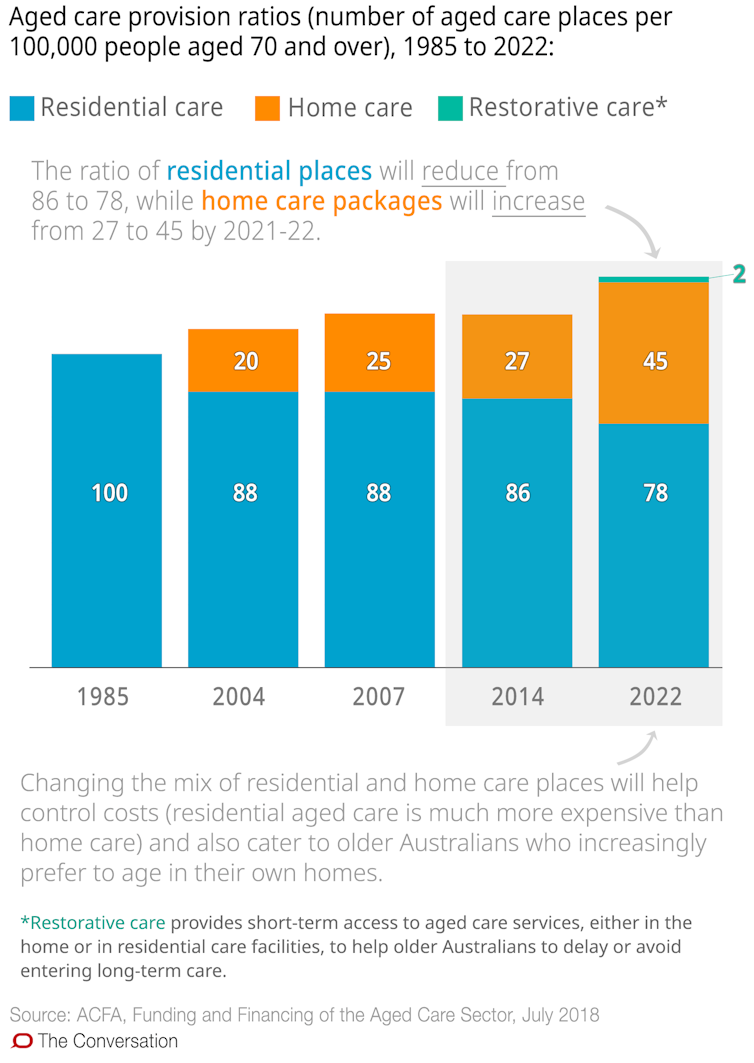 Minimum staffing levels
A 2015 survey by Bentley’s Chartered Accountants estimated that residents received an average of 2 hours and 48 minutes of care per day. The Australian Nursing and Midwifery Federation recommends residents receive 4 hours and 18 minutes of care per day.
The aged care industry does not currently have regulation related to minimum staffing levels, with the exception of a small number of publicly owned aged care homes Victoria.
Minimum staffing levels
A 2015 survey by Bentley’s Chartered Accountants estimated that residents received an average of 2 hours and 48 minutes of care per day. The Australian Nursing and Midwifery Federation recommends residents receive 4 hours and 18 minutes of care per day.
The aged care industry does not currently have regulation related to minimum staffing levels, with the exception of a small number of publicly owned aged care homes Victoria.
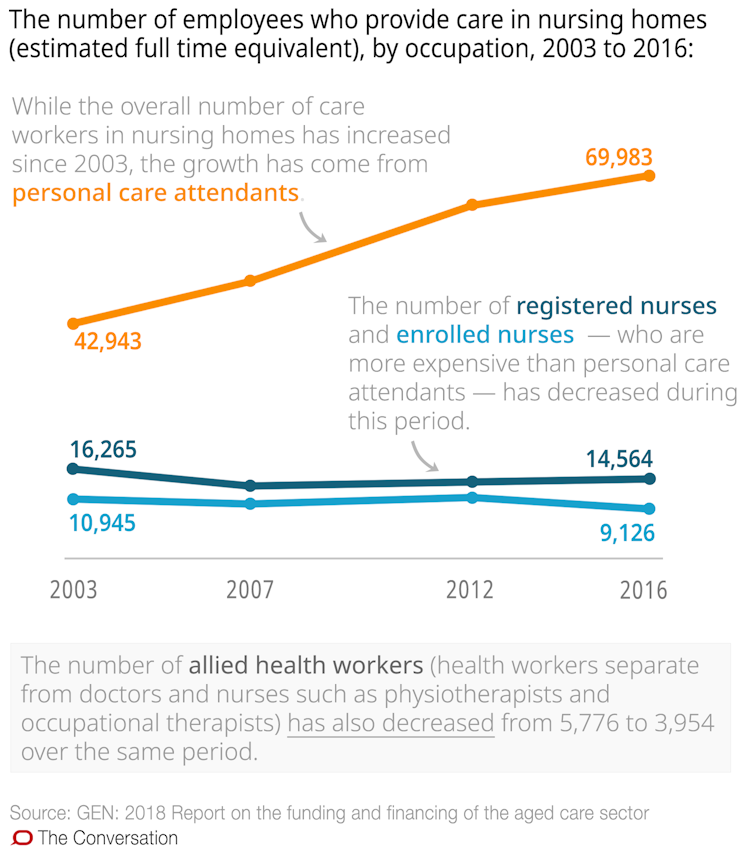 Read more:
Want to improve care in nursing homes? Mandate minimum staffing levels
The workforce and skills shortage
The Productivity Commission estimated in 2011 the workforce will need to grow to about 980,000 by 2050 to meet the demand of aged care consumers. (And the population projections this estimate is based on have increased substantially since then, so this number may end up being significantly higher).
But providers are already finding it difficult to adequately staff nursing homes, with 64% of residential care facilities reporting shortages in 2016. And with employee costs representing 70% of the total expenses for residential care providers (an increase from 67% of total expenses in 2015-16), there is concern that residents will not be given proper care.
Read more:
Want to improve care in nursing homes? Mandate minimum staffing levels
The workforce and skills shortage
The Productivity Commission estimated in 2011 the workforce will need to grow to about 980,000 by 2050 to meet the demand of aged care consumers. (And the population projections this estimate is based on have increased substantially since then, so this number may end up being significantly higher).
But providers are already finding it difficult to adequately staff nursing homes, with 64% of residential care facilities reporting shortages in 2016. And with employee costs representing 70% of the total expenses for residential care providers (an increase from 67% of total expenses in 2015-16), there is concern that residents will not be given proper care.
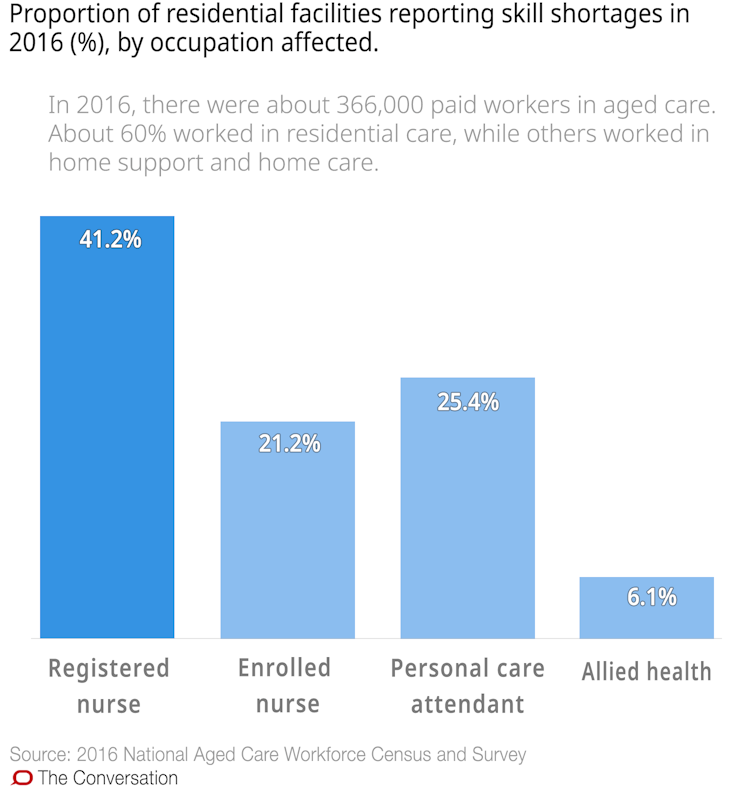 Residential care providers and their financial viability
There were 210,815 operational residential care places as at June 30 2018, an increase of about 24,500 places in the last five years. Over that time, the number of providers has decreased from 1,034 to 886, mainly due to consolidation.
Residential care providers and their financial viability
There were 210,815 operational residential care places as at June 30 2018, an increase of about 24,500 places in the last five years. Over that time, the number of providers has decreased from 1,034 to 886, mainly due to consolidation.
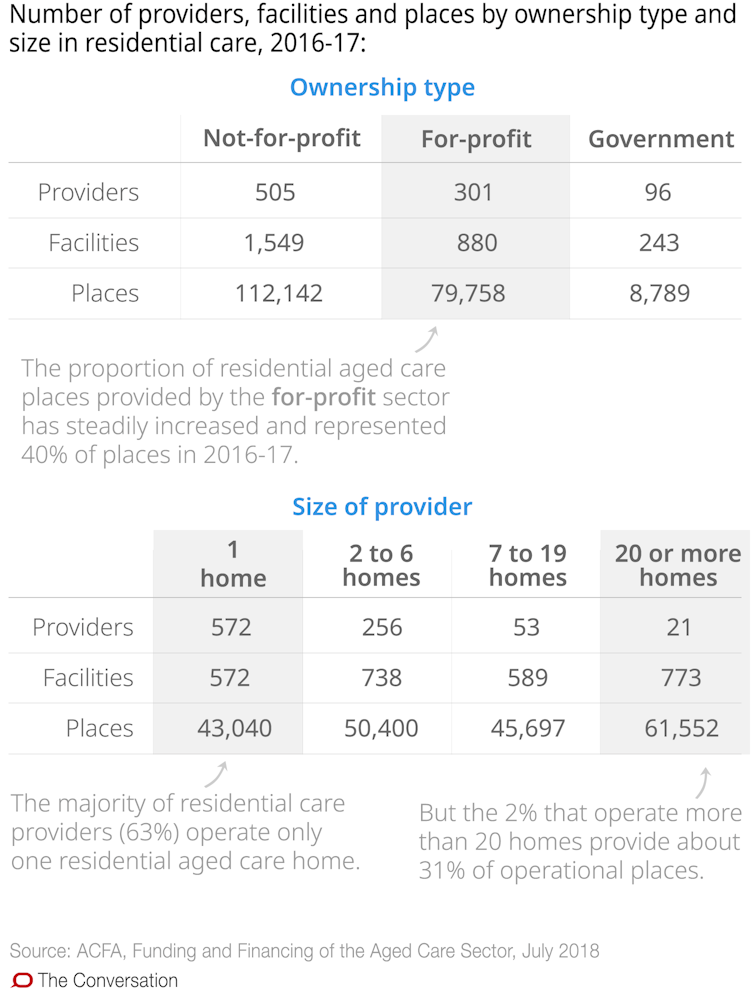 While profits (before tax) have almost doubled since 2012-13, only 68% of providers reported a net profit in 2016-17 (compared to 69% in 2015-16). A survey of more than 970 residential care facilities found 45% of facilities had negative earnings (before tax) in 2018, an increase from 33% in 2017.
While profits (before tax) have almost doubled since 2012-13, only 68% of providers reported a net profit in 2016-17 (compared to 69% in 2015-16). A survey of more than 970 residential care facilities found 45% of facilities had negative earnings (before tax) in 2018, an increase from 33% in 2017.
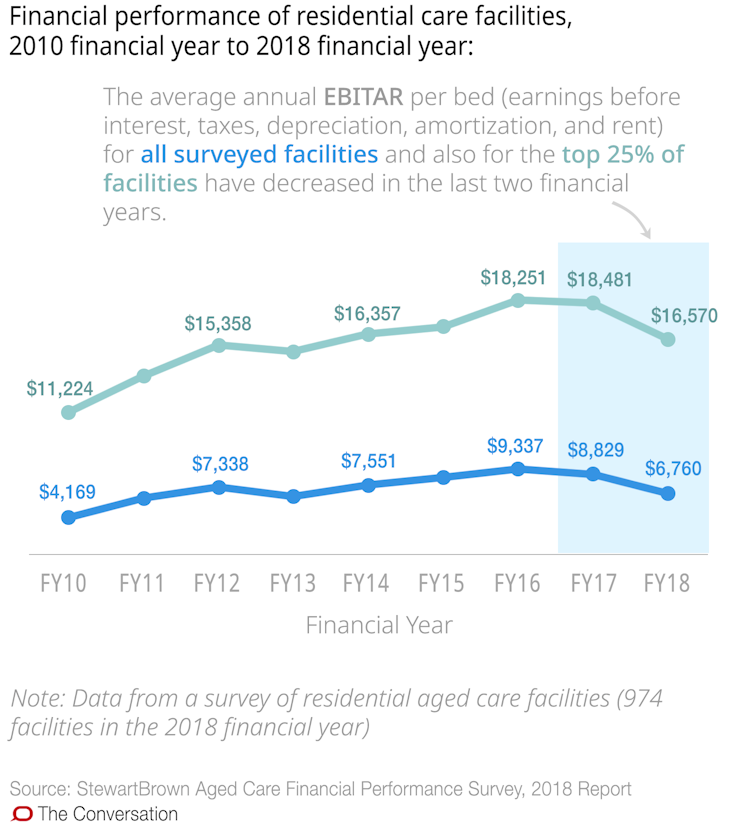 Funding for residential aged care
Residential aged care facilities require government funding as well as resident contributions to operate.
Government contributions accounted for 67.3% (A$12.4 billion) of total provider funding in 2017-18, the majority (89%) of which is made up of the basic care subsidy.
The subsidy is calculated for each resident based on their needs using the aged care funding instrument (ACFI). To care for a resident with high needs the provider will receive a larger subsidy.
Funding for residential aged care
Residential aged care facilities require government funding as well as resident contributions to operate.
Government contributions accounted for 67.3% (A$12.4 billion) of total provider funding in 2017-18, the majority (89%) of which is made up of the basic care subsidy.
The subsidy is calculated for each resident based on their needs using the aged care funding instrument (ACFI). To care for a resident with high needs the provider will receive a larger subsidy.
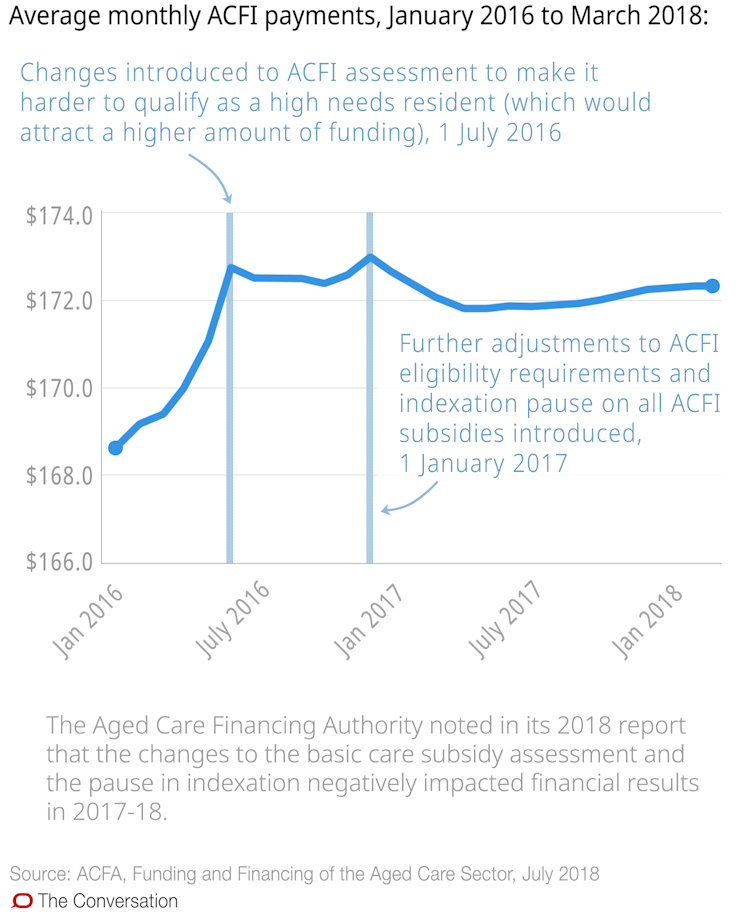
Authors: Emil Jeyaratnam, Data + Interactives Editor, The Conversation





